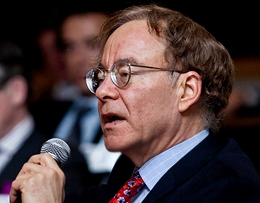On February 28, I submitted a letter on Money Market Fund Reform to the Financial Stability Oversight Council in response to their November 2012 request for comments on a number of alternative proposals. I endorse the so-called “Minimum Balance at Risk Proposal,” in which fund sponsors would create a capital buffer by contributing or raising capital of one percent of a money market fund’s assets while fund investors would be subject to delayed redemption of three percent of their account over $100,000. This approach could cause sponsors to internalize the costs of portfolio security selection while forcing large fund investors to internalize some of the costs of “running” on the fund during a crisis.
The letter has a novel legal argument, which is that the Dodd-Frank Act itself appears to contemplate capital for money market funds. Since the practical effect of the Dodd-Frank Act’s tightening of the Federal Reserve’s emergency lending authority (Federal Reserve Act sec.13(3)) is to require a collateral haircut, money market funds (especially with fixed net asset value) will need loss absorbing capital to access such a liquidity facility. The funds will not be able to put up collateral at par value because such collateral would be insufficient to protect taxpayers. Yet without a capital buffer, the valuation decrease associated with such a haircut could mean breaking the buck for a fixed NAV fund (that is, violating the $1 net asset value convention), which would force it to liquidate. The requirement that the Federal Reserve evaluate the collateral may also have a contagion effect, forcing a revaluation of portfolio assets at other funds as well as the borrowing fund. This adds to the importance of a capital buffer.
Money market funds are a novel financial intermediary, which arose out of regulatory arbitrage with an appeal principally for retail users who wanted a better interest rate deal than banks could offer. Some years later, institutional users found money market funds. These are cash-laden parties such as non-financial corporations, pension funds, securities lenders, and asset managers, that want more safety than what the official banking system offers and also unrestricted liquidity, all without paying the costs of systemic stability. That is not possible — unless, as now, the taxpayers bear the costs when the systemic bill comes due. The appeal of money market funds is the offer of a credit-screened diversified portfolio of financial assets that is safer than deposits in a single bank but highly liquid. If that value proposition holds, then the small restriction on liquidity and remote loss-bearing contingency should not be a significant disincentive for the institutional money market fund investor.
My full comment letter to the Financial Stability Oversight Council can be viewed here and a relevant paper co-authored by me and Christopher M. Gandia, Money Market Funds Run Risk: Will Floating Net Asset Value Fix the Problem?, is available here.
 Sky Blog
Sky Blog


Pingback: It can’t happen here?: Cyprus and money market funds
Pingback: SEC Proposes Money Market Fund Reforms | CLS Blue Sky Blog